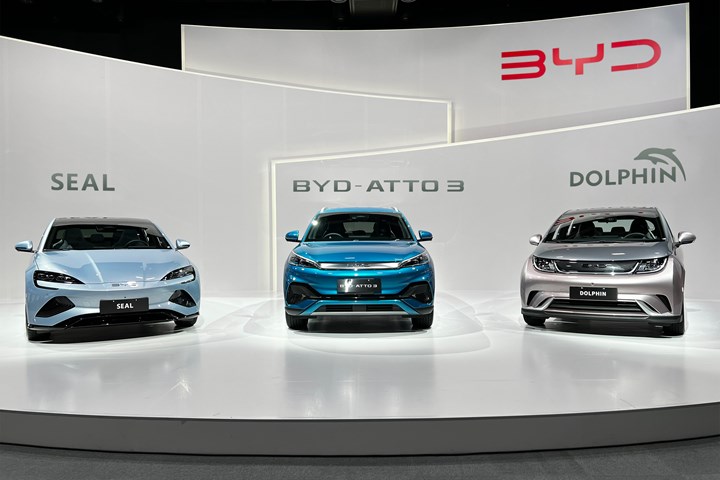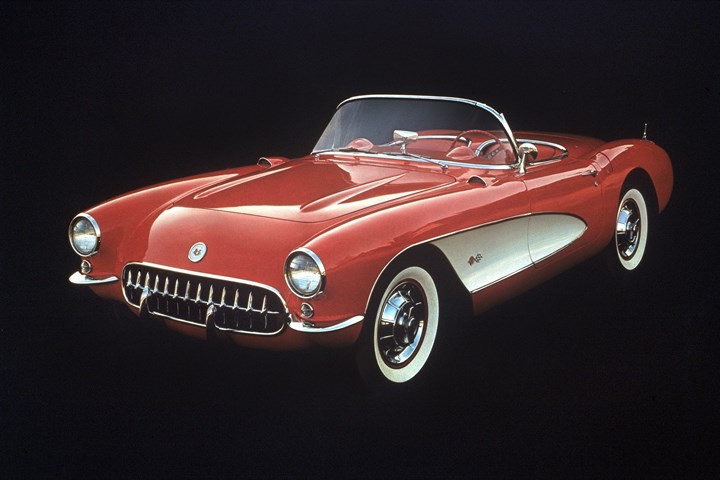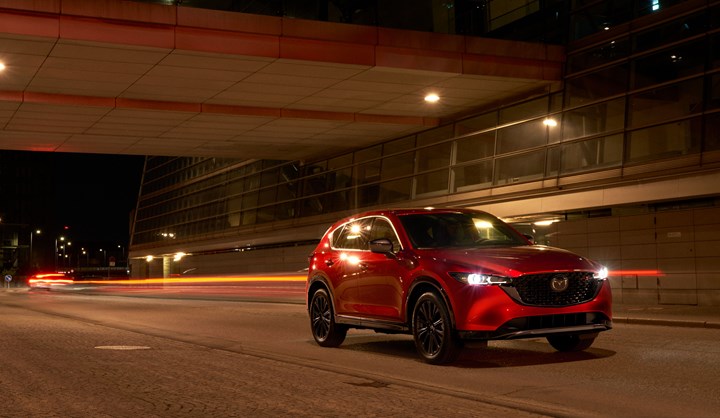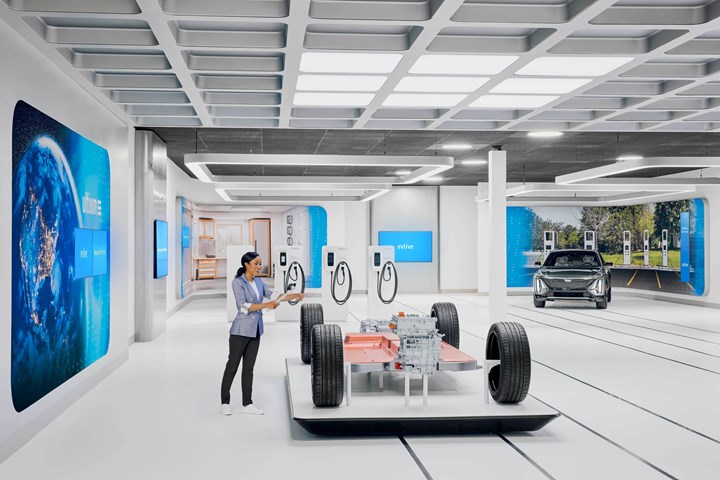on BYD, Tesla & robots, J.D. Power APEAL, the color of Corvettes, Mazda CX-5, GM EV Live & even more
BYD’s growing EV sales...another way Tesla is different. . .J.D. Power APEAL & gas prices...the colors of Corvettes. . .CX-5 review. . .GM launches EV Live. . .life cycle & leather. . .faux leather. . .VW making EVs in Chattanooga
Something to Keep in the Back of Your Mind

The BYD EV lineup that will be going to Japan. (Image: BYD)
Earlier this month it seemed as though Tesla, which operates a factory in Shanghai with an annual capacity of some 750,000 vehicles, was outsold during the first half of ’22. . .in China.
By a Chinese company.
The company in question is BYD.
(You may have heard about it because Warren Buffett’s Berkshire Hathaway owns about 8% of BYD.)
Turns out that while BYD sold 641,350 “new energy vehicles” during the first half and Tesla sold 564,743 vehicles, all of Tesla’s were fully electric and 323,519 of the BYD vehicles were EVs (per InsideEVs), with the balance being “electrified.”
If you’re betting, odds are that BYD will be number-one in EV sales in China before too long.
But you think: “Makes sense that a Chinese company would take the top spot in China. What’s the point?”
Well, it is about a potential step-by-step approach.
As in:
Last week BYD announced it will begin sales of EVs in Japan.
Liu Xueliang, General Manager of BYD Asia-Pacific Auto Sales Division:
"Starting from today, BYD, along with Japanese dealers and partners, will gradually establish a complete sales and service system to bring a low-carbon lifestyle and a better customer experience for the local people."
BYD JAPAN plans to launch the ATTO 3 SUV in January 2023 in Japan (it launched the vehicle in Australia in February ’22), which will be followed by the DOLPHIN and SEAL (a subcompact hatch and a sedan).
Meanwhile, in America. . .
Presently there are some 750 employees—unionized employees—building BYD battery electric buses in an ISO-9001 certified, 550,000-square foot factory in Lancaster, California. According to the company, the buses have >70% American content, which means they qualify for Buy America requirements for federally funded bus procurements.
Buses aren’t cars or crossovers, but evidently BYD is intent on expanding its sales footprint.
The attempts to sell U.S. vehicles in Japan fizzled. But here’s a company that intends to “gradually” gain in that market.
Consider
While some people might think that Chinese quality may not be up to snuff, realize that (1) BYD is bringing them to Japan, the country that (thanks to W. Edwards Deming) made quality a non-negotiable characteristic and (2) the Buick Envision that is possibly in a driveway near you is assembled in Shanghai.
By the way:
BYD stands for “Build Your Dreams.”
>>>
Reason #4,681 Reason Why Tesla Is Different Than Other OEMs

The Tesla factory in Shanghai has an annual capacity of ~750,000 vehicles. (Image: Tesla)
Speaking of Tesla. . .
“The architecture of electric vehicles allows us to rethink vehicle design and the manufacturing process beyond what was possible in the combustion engine era. Thanks to large castings and parts consolidation, the robot count in our body shops in new factories dropped by over 70% per unit of capacity compared to our first iteration of Model 3 Body Shop. Our quest for simplification is not over. We will continue to drive simplification further with every new product and every new factory.”—Tesla Q2 2022 Earnings Update Deck
Most OEMs boast about the number of robots in a plant.
Tesla accompanied that statement with a bar chart showing how the Model Y lines in Austin and Berlin have a fraction of the number of robots installed in Fremont.
This is not to say that Tesla doesn’t use robots in its factories. In fact, the deck includes photos of robots in the Berlin Model Y paint shop and the Austin Model Y body shop.
Still:
One of the approaches that seems to be fundamental to Tesla’s approach to process is “How come cars are built that way?,” even if it is something that is occurring in Tesla plants.
And if there is a better way, then it is no longer that way.
There’s a lesson there.
>>>
Gas Prices and Vehicle Appeal

2022 Dodge Charger SRT Hellcat Redeye: 797-hp, 6.2-liter supercharged V8. The EPA-combined fuel economy: 15 mpg. That said, for the second year running, Dodge is the #1 mass market brand in the 2022 APEAL Study. (Image: Dodge)
During the week of February 7, 2022, the average price of a gallon of gas in the U.S. was $3.53, according to the U.S. Energy Information Administration.
The week of May 30 had that price rise to $4.72.
During February to May J.D. Power surveyed 84,165 owners of new 2022 model year vehicles. These are vehicles that those people owned for 90 days.
This was for the 2022 U.S. APEAL Study—Automotive Performance, Execution and Layout.
APEAL simply asks people how they feel about their vehicles. There are 37 attributes, from seat comfort to throttle response and lots in between.
Product development people pour over this data as they work to identify the things they can put in their vehicles so that people will like them, really like them.
But there are some things that are outside their skill set.
Like that rise in gas prices.
Less satisfied
For the first time since 2014 and the fifth time in the 27 years the study has been conducted, something happened:
There was a decline in overall year-over-year vehicle satisfaction.
David Amodeo, director of global automotive at J.D. Power, said, “The most important factor leading to the industry decline this year is owners’ perception of their vehicle’s fuel economy.”
When gas prices rose $1.19 per gallon during those few weeks of the survey, suddenly, it seems, people started paying attention to fuel economy, something that those surveyed the previous year probably gave little thought to. (The prices for a gallon of gas were $2.49 the week of February 1, 2021 and $3.11 the week of May 31.)
According to Amadeo, this doesn’t mean that electrified vehicles were all sweetness and light in the survey, as he noted, “Battery electric vehicles have not been negatively affected by the increase in fuel costs but do have issues related to battery range and charging time.”
While the spread isn’t great, it turns out that gas prices notwithstanding, ICE vehicles are more appealing than EVs, plug-in hybrids (PHEV) and hybrids.
On a scale of 1,000 points (higher is better) the composite scores for those powertrains are:
- ICE: 846
- EV: 838
- PHEV: 835
- Hybrids: 832
J.D. Power pointed out that Tesla was absented from the EV composite score because the number of vehicles it has would skew the category.
>>>
The Color of Corvettes

1957 Corvette. No, not a 2022. But this is an excuse for showing a memorable car. . .that happens to be red. (Image: Chevrolet)
All Corvettes Are Red is the title of a book by James Schefter published in 1998 that describes the development of the C5 Corvette, the fifth generation of the car (1997 to 2004).
That title has always seemed appropriate to describe America’s sportscar, Ferrari red notwithstanding. (Even Prince thought so.)
The National Corvette Museum has released data about the model year 2022 C8 Corvette that proves the point (more or less).
The number-one color for the Corvette: Torch Red.
There was a total 4,147 Corvettes painted that color in model year ’22.
The other colors and the number of cars (coupes and convertibles combined):
- Arctic White: 3,603
- Hypersonic [purple]: 3,291
- Red Mist: 3,274
- Black: 2,766
- Rapid Blue: 2,261
- Elkhart Lake [blue]: 1,421
- Amplify [orange]: 1,375
- Ceramic Matrix: 1,202
- Accelerate [yellow] 1,193
- Silver Flare: 922
- Caffeine [brown]: 385
While certainly not all of the 25,831 vehicles are red, the combined Torch Red and Red Mist account for 29%, so by far the predominant color.
>>>
2022 Mazda CX-5 2.5 Turbo AWD

Mazda designers have mastered the art of Presence. (Image: Mazda)
This might be a nice problem to have.
Say you walk into a dealership.
You see two compact crossovers that are similar in styling, similar in size and similar in price.
These are not twins separated at birth.
They are two different vehicles, both with their own character. One more sophisticated. One more rugged(ish).
This is the case at Mazda. With the CX-5 and the newer CX-50.
As a consumer you are faced with two exceedingly good choices.
Try that at almost any other brand.
Just try.
///
Curious
Mazda has long been admired by driving enthusiasts because there has been keen attention paid to ride and handling of its vehicles. Whether it is an MX-5 (a.k.a., Miata) or a sizable CX-9 (length: 199.4 inches), these vehicles are tuned to have excellent road manners and I don’t mean that they’re setup so unless your bucket list contains a run on the Nordschleife they’re not for you.
Mazda has also been long admired by designers (professional and otherwise) because its Kodo design approach, which it has been refining since 2010, results in vehicles that appear as though they’d be on a show stand rather than in a Costco parking lot.
Mazda has the stuff. It completely surprises me that, comparatively speaking, it doesn’t have the sales of brands that put out perfectly adequate products.
///
The CX-5 in numbers
Size: 185.8 inches long, 75.6 inches wide, 63.9 inches high, with a 110.8-inch wheelbase.
Stuff: For people, 98 cubic feet. For whatever, 31 cubic feet.
Propulsion: 2.5-liter turbocharged four that produces 227 hp and 310 lb-ft of torque mated to a six-speed automatic. (I must confess that the six-speed transmission does puzzle me a bit as more gears seem to be in line with the segment.)
Some Features: Leather trimmed seats, with the driver’s and front passenger’s both powered (some OEMs thrift away that passenger power), heated and ventilated; windshield wiper de-icer (admittedly, I didn’t get to try this out, but that is the sort of technology that people can actually find great benefit from come February); the obligatory ADAS (e.g., blind-spot monitoring, lane departure warning, lane-keep assist, rear cross-traffic alert); radar cruise control; LED lighting all around; 10.25-inch color display; Bose 10-speaker audio. And that’s just the tip of the iceberg.
///
Quibble
This is really something when you get to something as, well, trivial as this.
- I don’t like the interface for the infotainment system. There are buttons (audio, home, navigation, back [good!], favorites) and a large knob that is rotated to run through selections and pushed to select the selection. There is a separate knob for the speaker volume. With time one would master this setup. But that said, is seems a bit fussy.
- I don’t like the setup for the wireless phone charger. It is in a bin in the console with an angled surface and a slightly raised lip to position the phone. While that lip would work if I didn’t have my phone in a case (admittedly a somewhat bulky Mophie charger case), but the lip was completely useless for me and so I wonder about the applicability.
The point is, there isn’t a whole lot not to like.
///
Best option
For a $595 on top of the $36,400 MSRP there is Soul Red Crystal Metallic paint. That color is extraordinary. I haven’t seen a richer finish on vehicles that have twice the price of the CX-5.
>>>
EVs and Education

Although it is difficult to see, that woman is holding a camera on the end of a selfie-stick as she explains to someone who is connected by GM’s EV Live some aspect of the electric vehicle. (Image: GM)
One of the challenges that electric vehicles face in the market is that although plenty of people have heard a lot about them. . .they don’t know a lot about them.
Sure, the early adopters and the technically oriented may be knowledgeable, but for the other 94% who haven’t bought an EV it isn’t simply an issue of availability that may be prohibiting their purchase.
General Motors—which hopes to have wide market acceptance when it starts rolling out vehicles including GMC Sierra EV, Chevrolet Silverado EV, Chevrolet Blazer EV and Chevrolet Equinox EV—figures that education is key to getting people into EVs.
“Addressing common misconceptions about EVs will accelerate widespread EV adoption. We saw a need for accessible, credible and engaging sources of information to empower consumers to adopt EVs and appreciate their many benefits."--Hoss Hassani, GM vice president of EV Ecosystem.
So on Monday it launched EV Live. This allows those interested in EVs (even dealer personnel or GM employees, along with the general public) to schedule one-on-one tours in an EV studio that GM has constructed that includes various properties, from charging stations to an Ultium chassis. The EV specialist is able to answer questions about EVs and to show (there is two-way audio and one-way video) various aspects of the EV experience.
Hassani: “We’re selling the EV experience, rather than specific EVs.”
Know This
Top topics that they anticipate they’ll be asked about most:
- Cost of ownership
- Maintenance
- Home and public charging
- Range
Hassani says that education is “arguably one of the most important aspects of getting people into EVs.”
He’s probably right.
>>>
Life Cycle and Leather

Cutting Bridge of Weir leather. (Image: Bridge of Weir)
When it comes to measuring an organization’s or a product’s impact on the environment, a life cycle analysis (LCA) is the best metric. This provides the most-comprehensive view of the state of affairs rather than simply assessing one slice.
Bridge of Weir Leather, which has been a supplier to the auto industry since the early 20th century, announced last week that it is the first auto leather manufacturer in the world to publish an independently verified LCA.
Dr. Warren Bowden, Head of Innovation and Sustainability at Scottish Leather Group, the parent company of Bridge of Weir:
“We are demonstrating that leather is a naturally sustainable product and that it should be produced in a responsible manner too.
“We are fully committed to our long-term goals of achieving net-zero carbon emissions and zero waste to landfill by 2025.”
According to the company, the hides for the leather are by-products of the local beef and dairy industries, with >98% sourced within the UK and Ireland. It has built a water treatment and recycling plant so that up to 40% of treated water is reused in production—and the company says it uses 50% less water per hide than the industry standard.
The company intends to reach zero-impact without resorting to carbon offsets.
Bowden: “We are also developing solutions to solve the challenge of end-of-life leather, through energy conversion, or partnering with our customers to repurpose their leather into new products.”
>>>
Leather-like But Not Leather

Silicone synthetic leather for automotive interiors is available in an array of colors. (Image: Sage)
While on the subject of interior materials. . .
Sage-ONF announced that it has launched production of silicone synthetic leather in a facility in Shanghai. The material is produced without solvents and plasticizers. It is said to have a “soft hand feel” on the one hand and “super resilient resistance to extreme temperatures” on the other.
It is a “petroleum-free, non-carbon-based product.”
>>>
Building EVs in Chattanooga

On July 26 the VW ID. 4 officially went into production at the Volkswagen of America plant in Chattanooga. (Image: VWoA)
Before Tuesday of this week you could count the number of electric vehicle models being produced for consumers* in the U.S. on one hand (Chevy Bolt EV, Bolt EUV, HUMMER EV, Ford F-150 Lightning, Cadillac LYRIQ.**)***
On Tuesday you had to add the second hand as Volkswagen of America (VWoA) officially announced start of production for the ID.4 compact EV SUV at its plant in Chattanooga.
Notable numbers
- Plans call for a ramp to 7,000 vehicles per month in Q4
- Two versions are being built: RWD and AWD. Both have an 82-kWh battery. The RWD version provides 201 hp and 229 lb-ft of torque. The AWD has a system output of 295 hp and 339 lb-ft of torque
- A second RWD variant with a 62-kWh battery will go into production later this year. (Why? Less powerful battery means a smaller sticker price)
- VWoA invested $800-million in the Chattanooga factory to build EVs
- 75,000 hours of training were conducted to prepare the workforce for EV production
- There are >4,000 employees at the plant. VWoA is in the process of adding 1,000 more through the end of he year
- VW has committed $7.1-billion in North America that will expand its product portfolio, including the production of the ID. Buzz electric microbus in 2024
- VWoA plans to have 55% of its U.S. sales to be EVs by 2030
Delivering on the plan
“When we promised to bring Volkswagen EVs to the millions, it always included American workers building those EVs right there in Chattanooga. We couldn’t be prouder to see that vision realized today with our ID.4 electric flagship rolling off the lines. This is another milestone in Volkswagen’s ambitious electrification strategy for the U.S. market and globally.”-- Thomas Schäfer, Chairman of the global Volkswagen brand.
-----
*The Ford E-Transit is for professionals
**Since this was originally posted, it was pointed out to me that there are actually other EVs—Tesla, of course, and Rivian. So if we give Tesla three and Rivian one (for now), that would bring the number to 9, with the ID.4 being 10. Still: 10 fingers.
***And now 11, as a keen-eyed reader pointed out that the Nissan LEAF is produced in Smyrna, Tennessee. So three hands. (The LEAF is something of an interesting case in that it was one of the original EVs yet has not managed to sustain the visibility it might deserve. And it isn’t doing that badly vis-a-vis sales, at least as regards other Nissan models. First half sales in the U.S. were 7,622. Which is better than Versa, at 5,626, and Maxima, at 3.753.)
RELATED CONTENT
-
Increasing Use of Structural Adhesives in Automotive
Can you glue a car together? Frank Billotto of DuPont Transportation & Industrial discusses the major role structural adhesives can play in vehicle assembly.
-
Robotic Exoskeleton Amplifies Human Strength
The Sarcos Guardian XO Max full-body, all-electric exoskeleton features strength amplification of up to 20 to 1, making 200 pounds—the suit’s upper limit—feel like 10 pounds for the user.
-
Rage Against the Machine
There have been more than 20 reported attacks against Waymo’s self-driving fleet in Chandler, Ariz., since the company began testing the technology on public roads there two years ago.


.jpg;width=70;height=70;mode=crop)






